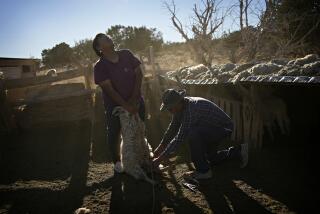Sheep Producers in U.S. Feel Pinch of Global Market
- Share via
GOODING, Idaho — Up before sunrise in a blowing snowstorm, John Faulkner is out in the barn repairing his truck. He’d driven home from Southern California just the night before but still must take more of his 12,000 sheep to Blythe for the winter.
It’s the grueling life of a third-generation sheepman, made all the more frustrating because he is losing money with every lamb he delivers to market.
“My incentive for getting up on mornings like this,” the 69-year-old rancher said, “is that I owe so much money.”
Throughout the West, from Texas to North Dakota to California, 66,000 sheep producers--all family-run operations--are struggling. Faulkner’s is one of the largest, so he is hurting more than most.
The chief reason: Currency exchange rates that mean lamb from overseas can be sold to American distributors at prices that sharply undercut U.S. producers. Even with the cost of shipping and a 3% tariff on imports, the exchange rate favors sheep ranchers in Australia and New Zealand--which rank first and second, respectively, in worldwide production--by about 40%.
U.S. Lamb Consumption Trails Other Meats
The domestic industry also is hurting because lamb remains a stranger on most American dinner plates--except among some ethnic groups and at Easter.
According to 2001 estimates by the U.S. Department of Agriculture, the annual per capita consumption of lamb is 1.3 pounds--compared with 68 pounds of pork, 91 pounds of chicken and 96 pounds of beef.
A lapse in the USDA’s reporting of wholesale lamb prices this year also exposed producers to a vacuum of competitive data that caused prices to plummet.
“When I was working up my budget [in June of this year for the coming 12 months], I asked my banker what my lambs were worth. And he said: ‘Wait a minute, let me go outside and ask that kid.’ That’s the problem these days,” Faulkner said. “Nobody knows.”
In a good year, producers such as Faulkner can sell lambs to processors for $1 a pound or more. They break even at about 80 cents a pound. This year, prices have dropped to as low as 35 cents a pound and now are hovering around 50 cents.
Half a Century Tending Sheep
Faulkner lost more than $400,000 this year. Back when the sheep business was prosperous, he bought up other ranches and herds that had dotted the rolling, sagebrush hillsides of south-central Idaho. Now he’s selling some of them to pay his bills.
“Sheep have made us money all but five or six of the 50 years I’ve been in the business,” he said. “And I’ve learned over the years that sometimes you have to sell farmland to make ends meet.”
Faulkner rattled off the names of five local sheepmen who have left the business because of plummeting lamb prices and have turned to cattle or farming. But not Faulkner.
“This is what I grew up with,” he said. “I’m too old to do anything different, and I’ve still got 10 years in me.”
He steps out into the snow--protected by a big, stained cowboy hat and heavy jacket--and drives his pickup to the corrals about 20 miles away. There his men are loading about 1,500 sheep into five livestock trailers for a caravan south to Blythe.
A half-dozen workers stand along the chute that funnels the single-file line of sheep up a ramp and into the four-level trailers. They poke the sheep with sticks to keep them moving, but the animals need little urging.
“The older ones will actually run over each other to try to get on the bus,” said Lason Cope, 24. “Every winter [when] we load them up, they know they’re heading to better feed.” Many of the sheep have made the trip to Blythe eight times; a few are 15-year veterans of the seasonal trek.
Faulkner will skip this trip, staying home to pore over the bills--payroll, fuel, electricity, truck repairs. And he wonders when the fickle lamb business will improve.
The enterprise seems straightforward enough.
From spring through fall, Faulkner’s sheep graze on the 13,000 acres that he and his brother own here. (His brother runs cattle and grows beets, corn and grain.)
When the snows come, Faulkner transports the sheep to 5,000 acres of alfalfa-rich range land that he leases from farmers near the California-Arizona border--a cheaper alternative than trucking baled hay to his animals here.
The sheep, which are bred in the summer, will deliver about 10,000 lambs in early January. He’ll keep nearly a fifth of them to replenish his aging stock and in the summer send the balance--weighing as much as 140 pounds each and yielding about half of that in meat--to market.
And every year he sells about 10% of his sheep, ones that are at least 6 or 7 years old, to satisfy the demands of customers, especially in Latin America, who prefer the stronger flavor of mutton.
So goes the cycle, year after year.
Faulkner worries about coyotes and other predators, about federal grazing leases, about water and feed, about refinancing his mortgages, about hiring maybe 40 sheepherders to manage the animals. But mostly, he worries about the price he’ll get for his lambs.
Even when prices are low at his end, the middlemen--the slaughterers, the breakers who cut down the carcasses to manageable pieces, the packagers, the distributors and the butchers--must fare well, he gripes, because the retail price remains relatively constant. Premium cuts like chops typically sell for around $7 per pound.
About 25% of the nation’s sheep producers have left the business since the early 1990s, said Peter Orwick, executive director of the American Sheep Industry Assn.
The government has offered little financial assistance to the industry, he said, even as imported lamb has flooded the market--representing 40% of all U.S. consumption today, compared with just 7% a decade ago.
“The single biggest factor has been the excess lamb production from Australia and New Zealand that was being shoved into the market at absolute cut-rate prices, pulling the lamb prices down for everybody,” Orwick said.
Tough to Stay Competitive
One of the sheepmen who abandoned the business is Brad Little, who is selling the 5,000 sheep he runs about 25 miles north of Boise, Idaho. He plans to focus instead on his cattle and farming business.
“It’s heartbreaking for my family because we go back with sheep into the 1800s,” he said. “But there’s no way now we can still compete on an international basis.”
He admires his friend Faulkner for sticking with sheep.
“For the amount of capital and work it takes, you’ve really got to love the sheep business,” Little said. “It takes grit and determination. And I’ve heard John say, when things get tough, ‘We’ll just have to work our way through it.’ ”
Faulkner curses the economics of his business but not the land--and surely not his sheep.
“All wealth comes from the land,” he said. “Logging, mining, farming, grazing. We get the first shot at the land. But we just don’t get the first shot at the money.
“I’m not greedy, but I would like to make a profit.”
*
Times researcher Lynn Marshall in Seattle contributed to this report.
More to Read
Inside the business of entertainment
The Wide Shot brings you news, analysis and insights on everything from streaming wars to production — and what it all means for the future.
You may occasionally receive promotional content from the Los Angeles Times.










